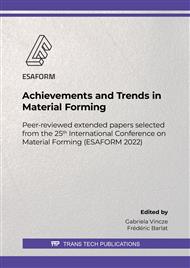[1]
J.-Y. Chen, K.-J. Yang, M.-S. Huang, Online quality monitoring of molten resin in injection molding, International Journal of Heat and Mass Transfer. 122 (2018) 681–693. https://doi.org/10.1016/j.ijheatmasstransfer.2018.02.019.
DOI: 10.1016/j.ijheatmasstransfer.2018.02.019
Google Scholar
[2]
H.-J. Luger, J. Miethlinger, Development of an online rheometer for simultaneous measurement of shear and extensional viscosity during the polymer extrusion process, Polymer Testing. 77 (2019) 105914. https://doi.org/10.1016/j.polymertesting.2019.105914.
DOI: 10.1016/j.polymertesting.2019.105914
Google Scholar
[3]
V. Mazzanti, F. Mollica, In-line rheometry of polypropylene based Wood Polymer Composites, Polymer Testing. 47 (2015) 30–35. https://doi.org/10.1016/j.polymertesting. 2015.08.003.
DOI: 10.1016/j.polymertesting.2015.08.003
Google Scholar
[4]
C. Pujos, N. Regnier, P. Mousseau, G. Defaye, Y. Jarny, Estimation Of Rheological Law By Inverse Method From Flow and Temperature Measurements With An Extrusion Die, AIP Conference Proceedings. 908 (2007) 1287–1294. https://doi.org/10.1063/1.2740987.
DOI: 10.1063/1.2740987
Google Scholar
[5]
Q. Lin, N. Allanic, R. Deterre, P. Mousseau, M. Girault, In-line viscosity identification via thermal-rheological measurements in an annular duct for polymer processing, International Journal of Heat and Mass Transfer. 182 (2022) 121988. https://doi.org/10.1016/j.ijheatmasstransfer.2021.121988.
DOI: 10.1016/j.ijheatmasstransfer.2021.121988
Google Scholar
[6]
C. Abeykoon, A.L. Kelly, E.C. Brown, P.D. Coates, The effect of materials, process settings and screw geometry on energy consumption and melt temperature in single screw extrusion, Applied Energy. 180 (2016) 880–894. https://doi.org/10.1016/j.apenergy.2016.07.014.
DOI: 10.1016/j.apenergy.2016.07.014
Google Scholar
[7]
W. Ostwald, About the rate function of the viscosity of dispersed systems, Kolloid Z. 36 (1925) 99–117.
Google Scholar
[8]
A. Waele, Viscometry and plastometry, Oil and Colour Chemists' Association. 6(1923) 33–88.
Google Scholar
[9]
R. Deterre, F. Nicoleau, Q. Lin, N. Allanic, P. Mousseau, The flow of power-law fluids in concentric annuli: A full analytical approximate solution, Journal of Non-Newtonian Fluid Mechanics. 285 (2020) 104392. https://doi.org/10.1016/j.jnnfm.2020.104392.
DOI: 10.1016/j.jnnfm.2020.104392
Google Scholar
[10]
J.-F. Agassant, P. Avenas, P.J. Carreau, B. Vergnes, M. Vincent, Polymer processing: principles and modeling, Carl Hanser Verlag GmbH Co KG, (2017).
DOI: 10.3139/9781569906064.fm
Google Scholar
[11]
C.S. Kim, Thermophysical properties of stainless steels, Argonne National Lab., Ill. (USA), 1975. https://doi.org/10.2172/4152287.
Google Scholar
[12]
X. Zhang, M. Fujii, Measurements of the thermal conductivity and thermal diffusivity of polymers, Polymer Engineering & Science. 43 (2003) 1755–1764. https://doi.org/10.1002/pen.10148.
DOI: 10.1002/pen.10148
Google Scholar


